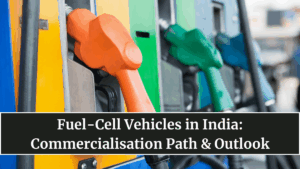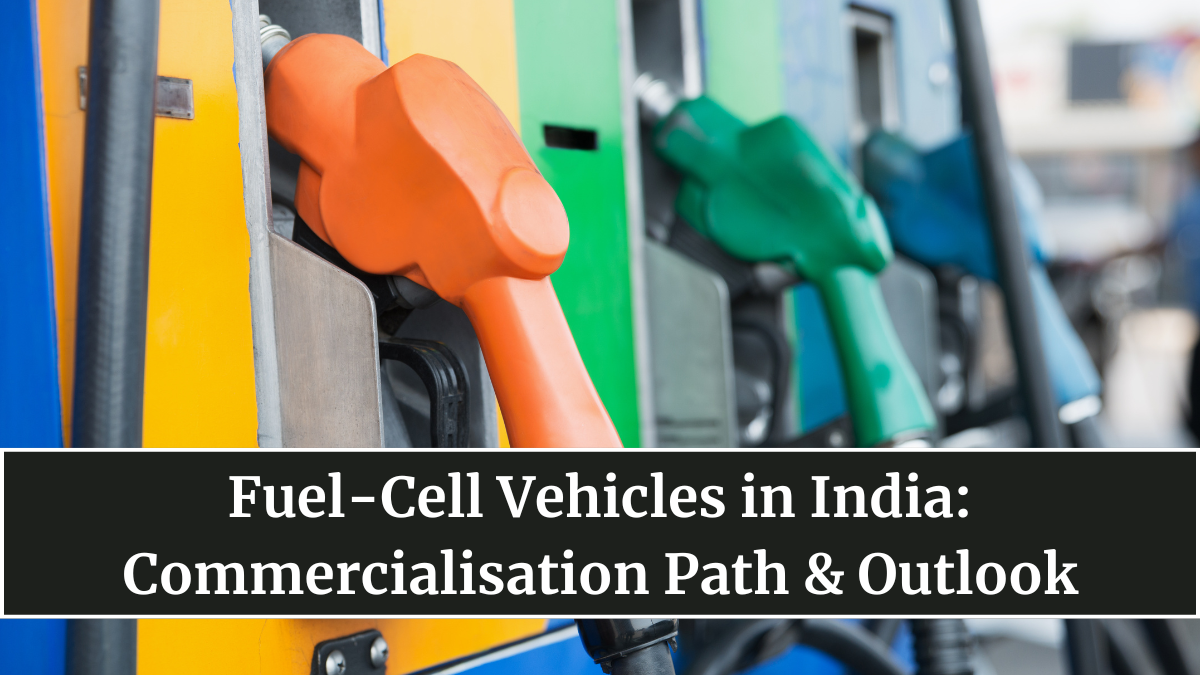India’s clean mobility revolution is expanding beyond batteries — it’s now embracing hydrogen. The India fuel cell vehicles commercialisation journey marks the beginning of a new chapter in the country’s alternative fuel strategy. As policymakers, automakers, and energy giants invest heavily in hydrogen infrastructure, Fuel-Cell Electric Vehicles (FCEVs) are emerging as the next big leap in sustainable transport.
While battery EVs currently dominate the electric mobility space, FCEVs offer unique advantages for long-distance travel, heavy-duty applications, and quick refueling — areas where battery-powered vehicles still face challenges.

What Are Fuel-Cell Vehicles and How They Work
A fuel-cell vehicle generates electricity through an electrochemical reaction between hydrogen and oxygen, producing only water vapor as exhaust. Unlike battery EVs, which store electricity, FCEVs produce it on demand.
The main components include:
-
Hydrogen tank: Stores compressed hydrogen gas.
-
Fuel-cell stack: Converts hydrogen and oxygen into electricity.
-
Electric motor: Uses that electricity to power the vehicle.
This system offers the range of an ICE vehicle and the clean efficiency of an EV, making it an ideal bridge technology between combustion and full electrification.
India’s Push Toward Hydrogen Mobility
The Government of India has identified hydrogen as a critical pillar under its National Green Hydrogen Mission (NGHM), launched in 2023 with a target to make India a global hub for hydrogen production, storage, and export.
Key initiatives driving FCEV development include:
-
Hydrogen refueling pilots: Delhi, Pune, and Bengaluru are setting up refueling stations under public-private partnerships.
-
Government collaboration: Oil PSUs like IOCL, BPCL, and HPCL are building hydrogen distribution infrastructure.
-
Incentives for FCEVs: Similar to EVs, incentives are being extended to promote research and early adoption.
-
Heavy vehicle pilots: Tata Motors and Ashok Leyland are testing hydrogen-powered buses and trucks for long-distance logistics.
The first hydrogen FCEV pilot in India was launched by Toyota Kirloskar Motor in collaboration with the Ministry of Road Transport and Highways, using the globally acclaimed Mirai FCEV as a test vehicle on Indian roads.
Key Players in India’s Fuel-Cell Transition
Several Indian and international companies are now actively investing in the hydrogen ecosystem.
| Company | Focus Area | Project Type | Status |
|---|---|---|---|
| Toyota Kirloskar Motor | Passenger FCEV | Hydrogen pilot fleet | Ongoing trials |
| Tata Motors | Hydrogen trucks & buses | Heavy mobility | Testing phase |
| Ashok Leyland | Hydrogen ICE and FCEV hybrids | Long-haul logistics | Development stage |
| Indian Oil Corporation (IOCL) | Hydrogen refueling infrastructure | 10+ stations planned | Under construction |
| Reliance Industries | Green hydrogen production | Refining & export | Expansion phase |
These initiatives are gradually building the foundation for a domestic hydrogen value chain, integrating fuel production, distribution, and vehicle manufacturing.
Advantages of Hydrogen Fuel-Cell Vehicles
FCEVs bring several compelling advantages over traditional vehicles and even battery EVs:
-
Faster refueling: Hydrogen refueling takes only 3–5 minutes, similar to petrol or diesel.
-
Longer range: Can cover 600–700 km on a single tank, ideal for intercity and freight transport.
-
Lightweight design: Fuel cells are more suitable for heavy-duty and commercial vehicles.
-
Zero tailpipe emissions: Only water vapor is released, drastically cutting air pollution.
-
Scalability: Hydrogen can power multiple mobility segments — from cars to buses and even ships.
With India’s focus on renewable hydrogen production, FCEVs could soon play a major role in decarbonizing transport and logistics.
Challenges on the Road to Commercialisation
Despite strong potential, the widespread rollout of FCEVs faces notable challenges:
-
High costs: Hydrogen fuel cells and tanks remain expensive due to low production volumes.
-
Limited infrastructure: India currently has fewer than 10 operational hydrogen refueling stations.
-
Storage and safety concerns: Hydrogen requires high-pressure containment and stringent safety standards.
-
Public awareness: Consumers and fleet operators are still unfamiliar with hydrogen technology.
Addressing these issues will require coordinated action from automakers, fuel companies, and policymakers, along with long-term investments in R&D and infrastructure.
The Road Ahead for Hydrogen Mobility in India
India’s fuel-cell future looks promising, particularly in the commercial and logistics sectors. Hydrogen-powered buses and trucks are expected to play a key role in long-distance transport, where battery EVs struggle with weight and charging times.
Government-backed projects are also exploring green hydrogen production using renewable energy, making FCEVs part of a truly carbon-neutral cycle. By 2030, India could see hydrogen vehicles accounting for 5–10% of its clean mobility fleet, with refueling corridors linking major industrial and transport hubs.
The combination of policy, innovation, and investment is positioning India to not only adopt but also lead hydrogen mobility development across Asia.
FAQs
What is a fuel-cell vehicle?
A fuel-cell vehicle runs on hydrogen, which reacts with oxygen to produce electricity — emitting only water vapor as exhaust.
How are fuel-cell vehicles different from battery EVs?
Unlike battery EVs that store energy, FCEVs generate electricity on demand, offering longer range and faster refueling.
Which companies are developing hydrogen vehicles in India?
Major players include Toyota, Tata Motors, Ashok Leyland, and Indian Oil Corporation, each working on hydrogen pilots.
What are the main challenges in adopting FCEVs?
High costs, limited hydrogen infrastructure, and storage safety concerns are key barriers to mass adoption.
What is India’s goal for hydrogen mobility?
Under the National Green Hydrogen Mission, India aims to become a global hub for hydrogen production and achieve significant commercialisation of fuel-cell vehicles by 2030.
Click here to know more.
